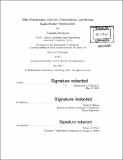| dc.contributor.advisor | Keith A. Nelson. | en_US |
| dc.contributor.author | Sivarajah, Prasahnt | en_US |
| dc.contributor.other | Massachusetts Institute of Technology. Department of Chemistry. | en_US |
| dc.date.accessioned | 2017-12-05T19:13:02Z | |
| dc.date.available | 2017-12-05T19:13:02Z | |
| dc.date.copyright | 2017 | en_US |
| dc.date.issued | 2017 | en_US |
| dc.identifier.uri | http://hdl.handle.net/1721.1/112443 | |
| dc.description | Thesis: Ph. D., Massachusetts Institute of Technology, Department of Chemistry, 2017. | en_US |
| dc.description | Cataloged from PDF version of thesis. | en_US |
| dc.description | Includes bibliographical references (pages 195-206). | en_US |
| dc.description.abstract | On the terahertz (THz) polaritonics platform, ultrafast optical laser pulses are used to generate and detect THz phonon-polariton wavepackets with full spatiotemporal resolution while they are confined to a thin slab of lithium niobate (LN) or lithium tantalate (LT) that is roughly 30-100 pm thick. Polaritonics is an attractive platform for wave-based computing because of its wealth of capabilities, but still requires the study and development of some critical features before applications can be fully realized. In my thesis work, I investigated and developed two of these features: photonic structures and strong light-matter coupling. In the first phase, we developed a fabrication procedure to pattern high-aspect ratio, optical-quality air holes into slabs of LN and LT, which has been historically difficult to achieve. We then studied the nature of THz wave propagation in the slabs when the size of these air holes was either much smaller or comparable to the THz wavelength. In the long-wavelength limit, where the structures are normally approximated as homogenous media, our findings were used to determine a cutoff-wavelength for operation and design of gradient refractive index devices. In the short wavelength limit, where the structures are termed photonic crystals, our work challenged the universally used definition of the Brillouin zone and presented an alternative definition that was valuable in understanding wave propagation in periodically ordered systems. In the second phase, we demonstrated a novel form of light-matter interaction in the strong coupling regime, where phonons and magnons where strongly coupled to the electric and magnetic fields of THz light, respectively. Our experiments, performed in both waveguide and cavity geometries, conclusively proved the formation of new quasiparticles we termed magnon-phonon-polaritons. We believe our results open up the possibility of using polaritonics for facile and coherent ultrafast control and conversion between photonic, phononic, and spin degrees of freedom, and thereby provides a promising avenue through which to explore THz wave-based computing. Our cavity geometry and sensitive detection scheme should also provide a means by which to pursue the field of THz cavity quantum electrodynamics. | en_US |
| dc.description.statementofresponsibility | by Prasahnt Sivarajah. | en_US |
| dc.format.extent | 206 pages | en_US |
| dc.language.iso | eng | en_US |
| dc.publisher | Massachusetts Institute of Technology | en_US |
| dc.rights | MIT theses are protected by copyright. They may be viewed, downloaded, or printed from this source but further reproduction or distribution in any format is prohibited without written permission. | en_US |
| dc.rights.uri | http://dspace.mit.edu/handle/1721.1/7582 | en_US |
| dc.subject | Chemistry. | en_US |
| dc.title | THz polaritonics : control, confinement, and strong light-matter interactions | en_US |
| dc.title.alternative | Terahertz polaritonics | en_US |
| dc.type | Thesis | en_US |
| dc.description.degree | Ph. D. | en_US |
| dc.contributor.department | Massachusetts Institute of Technology. Department of Chemistry | |
| dc.identifier.oclc | 1008887929 | en_US |
